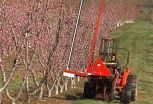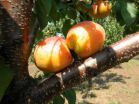(Press-News.org) UNIVERSITY PARK, PA -- Growing plants on rooftops is an old concept that has evolved from simple sod roofing to roof gardens and new, lightweight "extensive green roofs". Modern green roofs have environmental and social benefits; they can reduce stormwater runoff, improve air quality, mitigate urban heat, reduce the demand for air conditioning and greenhouse gas emissions, and provide habitat for birds and wildlife. Long-used in urban planning in Europe, green roofs are becoming more popular in North America, and new research designed to promote the integration of green roofs into current and future buildings is burgeoning. Researchers from the Department of Horticulture at The Pennsylvania State University published a study in HortTechnology that evaluated the influence of substrate type and depth on establishment of five common green roof plants.
Plants suitable for extensive green roofs must tolerate extreme rooftop conditions, and the substrates in which they grow must meet both horticultural and structural requirements. Deeper substrates may retain more water for plants during dry periods, but they also weigh more, especially when near saturation. The study by Christine E. Thuring, Robert D. Berghage, and David J. Beattie was designed to evaluate the effects of substrate type and depth on the establishment and early growth of five plants popular in North American green roof designs.
The researchers hypothesized that early drought is more harmful for plants grown in shallow rather than deeper substrate depths, and that plants that survived early drought conditions would produce less shoot biomass than those subjected to late drought. Two stonecrops, one ice plant, and two herbaceous perennials were planted in three depths (30, 60, and 120 mm) of expanded shale and expanded clay, two commercially available green roof substrates. Study flats inside a plasticulture tunnel received three drought treatments: no drought, 2 weeks early drought, and 2 weeks late drought.
The two stonecrops performed well under most conditions, although tasteless stonecrop was stunted by early drought. Ice plant performed erratically and, along with maiden pink, poorly in face of drought during establishment. When subjected to any drought, the herbaceous perennials had the fewest survivors in the expanded shale. The study plants were most affected by substrate depth, except for maiden pink, which responded solely to drought. When subjected to early drought conditions, the herbaceous perennials did not survive in 30 mm of either substrate, or in 60 mm of expanded shale; early drought appeared to be more harmful to plant survival and performance than late drought. Although the stonecrops performed well in 60 mm of substrate when subjected to drought, their performance was superior in the expanded clay compared with shale.
The three most resilient species used in the study—saxifrage pink, white stonecrop, and tasteless stonecrop—always produced more shoot biomass with increasing substrate depth, regardless of water availability. A standout performer was saxifrage pink, which had an attractive appearance and persistent flowering habit, making it an excellent choice as a green roof plant.
The experiment illustrates how appropriate species selection in the design of unirrigated extensive green roofs may be directed by factors such as substrate type and depth, as well as anticipated drought conditions. "This experiment revealed the variability among drought-tolerant species to various treatments, as well as the different plant responses to substrate type during drought", concluded the scientists.
###
The complete study and abstract are available on the ASHS HortTechnology electronic journal web site: http://horttech.ashspublications.org/cgi/content/abstract/20/2/395
Founded in 1903, the American Society for Horticultural Science (ASHS) is the largest organization dedicated to advancing all facets of horticultural research, education, and application. More information at ashs.org
How does your green roof garden grow?
5 common green roof plants tested for optimal substrate, drought conditions
2010-12-30
ELSE PRESS RELEASES FROM THIS DATE:
Uncovering the neurobiological basis of general anesthesia
2010-12-30
The use of general anesthesia is a routine part of surgical operations at hospitals and medical facilities around the world, but the precise biological mechanisms that underlie anesthetic drugs' effects on the brain and the body are only beginning to be understood. A review article in the December 30 New England Journal of Medicine brings together for the first time information from a range of disciplines, including neuroscience and sleep medicine, to lay the groundwork for more comprehensive investigations of processes underlying general anesthesia.
"A key point of ...
Doctors should be required to disclose sleep deprived status to patients before elective surgeries
2010-12-30
While regulations have been put in place to restrict the work hours of doctors in training, no such regulations exist for fully trained physicians. An editorial in this week's New England Journal of Medicine argues that sleep-deprived physicians should not be permitted to proceed with an elective surgery without a patient's informed, written consent.
According to the authors, "This approach would represent a fundamental shift in the responsibility patients are asked to assume in making decisions about their own care and might prove burdensome to patients and physicians ...
Team-based approach to care shows success in fight against depression with diabetes, heart disease
2010-12-30
SEATTLE—Many people in the U.S. have multiple common chronic diseases such as diabetes and heart disease, which complicates health care needs. When depression coexists with diabetes, heart disease, or both, health outcomes are often less favorable.
In a randomized controlled trial, testing a primary care intervention called TEAMcare, nurses worked with patients and health teams to manage care for depression and physical disease together, using evidence-based guidelines. The result for patients: less depression, and better control of blood sugar, blood pressure and cholesterol ...
Trace amounts of microbe-killing molecules predict chronic granulomatous disease survival
2010-12-30
Investigators at the National Institutes of Health have observed that the survival rate of people with a rare immunodeficiency disease called chronic granulomatous disease (CGD) is greatly improved when even very low levels of microbe-killing molecules are present. Because production of these molecules, made by an enzyme called NADPH oxidase, can be predicted from genetic analysis, a patient's risk for severe CGD could be assessed very early in life, allowing for more personalized treatment, say the researchers.
The study was conducted at the NIH Clinical Center and ...
UNC scientists pinpoint link between light signal and circadian rhythms
2010-12-30
Chapel Hill, NC – In a new paper published this week in the Proceedings of the National Academy of Sciences, Aziz Sancar, MD, PhD, the Sarah Graham Kenan Professor of Biochemistry and Biophysics in the UNC School of Medicine, and his colleagues have taken an important step in understanding the underlying molecular signals that influence a broad array of biological processes ranging from the sleep-wake cycle to cancer growth and development.
Scientists who work in this field, known as chronobiology, have identified the genes that direct circadian rhythms in people, mice, ...
Hybrid string blossom thinner tested in peach orchards
2010-12-30
GETTYSBURG, PA – Peach producers have traditionally relied heavily on hand thinning, a necessary but costly and labor-intensive field practice. Impacted by increasing labor costs and a limited workforce, peach and other stone fruit growers are turning to mechanical methods such as string thinners to minimize the need for hand thinning. A new ''hybrid'' string thinner prototype showed promising results when it was evaluated in four U.S. growing regions; the trials resulted in significant labor savings and increased peach size.
According to Pennsylvania State University's ...
Genetic relationship between Hungarian and Turkish apricots confirmed
2010-12-30
BUDAPEST, HUNGARY – Apricots are important to Turkey, the country where more apricot crops are grown and exported than anywhere in the world. Looking to unlock the mystery of apricots' origins and increase crop production, scientists are studying the genetic relationship between apricot varieties. New research from a team of Hungarian and Turkish scientists has confirmed the genetic link between Turkish and Hungarian apricot cultivars, yielding information that provides valuable data for apricot growers and breeders.
It is widely believed that apricots originated in China, ...
Turfgrass fertility, pesticide programs compared
2010-12-30
WEST LAFAYETTE, IN – Traditional turfgrass management programs rely heavily on the use of synthetic pesticides and fertilizers. In response to increased public scrutiny and legislation, organic and biological alternatives are becoming more accepted, but research indicates that these alternatives have not been widely adopted by either homeowners or the lawn care industry. Results of a new study that compared common but disparate turfgrass management approaches may help lawn care professionals to evaluate, market, and implement alternative management programs.
Purdue University ...
Indoor plant intervention: New answers for health care design?
2010-12-30
NORWAY – Could a plant "intervention" improve the well-being of patients in a difficult rehab process? Scientists from the Norwegian University of Life Sciences and Sweden's Uppsala University investigated this question in a recent study of 436 coronary and pulmonary patients at a Norwegian rehabilitation center. The results were published in HortScience. Ruth Kjærsti Raanaas, Grete Grindal Patil, and Terry Hartig studied the effects of an indoor plant intervention during a 2-year study conducted at the Røros Rehabilitation Center. The experiment showed that patients' overall ...
Children in areas with few pediatricians at higher risk for serious appendix ruptures
2010-12-30
Children who live in areas with fewer pediatricians are more likely to suffer life-threatening ruptures of the appendix than those in areas with more pediatricians, even when accounting for other factors such as the number of hospitals, imaging technology, insurance coverage and the number of surgeons in an area, according to a study from the Johns Hopkins Children's Center.
The study's findings, based on an analysis of nearly 250,000 hospital records of children with appendicitis, are published online in the December issue of JAMA-Archives of Surgery.
"Our analysis ...
LAST 30 PRESS RELEASES:
School meals could unlock major gains for human and planetary health
Menopause hormone therapy does not appear to impact dementia risk
Signature patterns of brain activity may help predict recovery from traumatic brain injury
Dresden study uncovers new key mechanism in cancer cells
New species are now being discovered faster than ever before, study suggests
Cannabis-based products show limited short-term benefit for chronic pain, with increased risk of adverse effects
Cannabis products with more THC slightly reduce pain but cause more side effects
Clearing the brain of aging cells could aid epilepsy and reduce seizures
Brain injuries linked with potential risk of suicide, new study finds
New technique lights up where drugs go in the body, cell by cell
New study finds movement of fishing fleets can reveal shifts in marine ecosystems
Embargoed: New evidence points to potential treatment for vascular dementia
Study uncovers disrupted brain balance in alcohol dependence
Working in groups can help Republicans and Democrats agree on controversial content moderation online
Structural findings reveal how distinct GPCR ligands create different levels of activation
Anything-goes “anyons” may be at the root of surprising quantum experiments
UC review: Maximizing workplace opportunity for veterans
From generation to complex control: Metasurfaces make perfect vortex beams "within reach"
Thin-film lithium niobate-based detector: recent advances and perspectives
Exploring why some people may tend to persistently make bad choices
How cells balance their protein levels
Nirsevimab vs RSVpreF vaccine for RSV–related hospitalization in newborns
Effectiveness and impact of maternal RSV immunization and nirsevimab on medically attended RSV in US children
AI gives scientists a boost, but at the cost of too many mediocre papers
Next-generation vision model maps tree growth at sub-meter precision
Genes aren’t destiny for inherited blindness, study shows
MIT study: High-fat diets make liver cells more likely to become cancerous
Exposure to multiple fine particulate matter components and incident depression in the US Medicare population
Risk of burdensome health care spending over time in the US
Nirsevimab against hospitalizations and emergency department visits for lower respiratory tract infection in infants
[Press-News.org] How does your green roof garden grow?5 common green roof plants tested for optimal substrate, drought conditions




